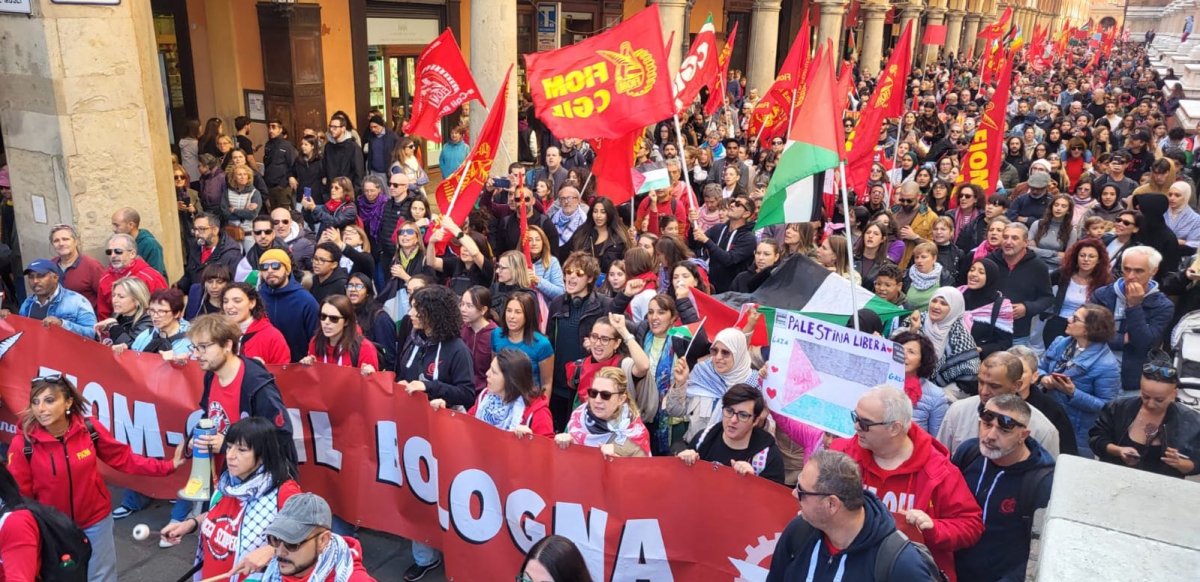Millions of Italians Join General Strike for Gaza

Two million people joined a general strike called by Italian unions to defend the flotilla carrying humanitarian aid to Gaza. Photo: FIOM CGIL Nazionale
More than 2 million people filled public squares across Italy on October 3 during a one-day general strike in support of the people of Gaza and against the ongoing genocide there. The strike, called by the Italian General Confederation of Labour (CGIL) and grassroots unions, drew extraordinary participation from workers, students, families, and dozens of secular and religious associations.
The strike was part of a week of massive actions that began on October 1, when the Israeli navy blocked the Global Sumud Flotilla that was carrying aid to Gaza. The flotilla, launched in August, aimed to break the Israeli blockade of humanitarian aid and end the devastating attack on the people of Gaza. Among the hundreds of volunteers on board the boats were 40 Italians, including four legislators and some rank-and-file members of CGIL and the Grassroots Base Union (USB).
News of Israel’s action, and its arrest of those aboard the flotilla, sent people into the streets in dozens of cities across Italy. The next day, crowds gathered in front of the Colosseum in Rome, and in main squares and government buildings throughout the country. The CGIL, Italy’s largest labor confederation, then called a general strike for October 3 “in defense of the Global Sumud Flotilla, constitutional values, to stop the genocide, and in support of the people of Gaza.”

SUPPORT LABOR NOTES
BECOME A MONTHLY DONOR
Give $10 a month or more and get our "Fight the Boss, Build the Union" T-shirt.
Another enormous wave of protest came on October 4, when a million people poured into the center of Rome chanting “Free Palestine.” It was a level of participation unmatched in recent history. Young people, families, and ordinary citizens joined members of unions and civic organizations in the river of people filling the streets of Italy’s capital. “We wanted to liberate Palestine, and instead Palestine is liberating us,” read one brilliant sign. The protest was organized by the Palestinian Student Movement and the Palestinian Arab Democratic Union, and included the CGIL, the USB, student and university groups, the National Association of Partisans, and the Arci (the Italian Cultural and Recreational Association).
In a statement, CGIL called the October 3 general strike a success. According to CGIL, 300,000 people marched in Rome that day. About 100,000 marched in each of the Italian cities of Milan, Bologna, Florence, and Turin. Naples, Genoa, Palermo, and Venice also held huge protests. In all, over 100 cities participated.
The day was characterized by a peaceful and democratic atmosphere. CGIL General Secretary Maurizio Landini emphasized “the extraordinary and unprecedented participation of young people, who are demanding a future of peace and social justice, with stable employment and a fight against precarious employment.”
BIGGER PICTURE
October 3 was not the first general strike for Gaza. The CGIL, with over 5.1 million members and affiliated with the ITUC, called a national strike on September 16, the day after the Netanyahu government decided to launch the final invasion of Gaza City. Most trade unions—except public sector workers, who are barred from striking—called a four-hour strike. But in some areas the strike lasted eight hours. Everywhere, in hundreds of cities, the protests and demonstrations were packed.
The grassroots union USB had already called a general strike for September 22, and that day too was characterized by enormous participation, especially since it involved schools and gave tens of thousands of students, from middle school to college, a chance to join protests in cities across the country.
Separately, in their governing bodies, the CGIL, the USB, and other grassroots unions announced that they would call a “political strike” in defense of the Italian Constitution, whose Article 11 “repudiates war,” if the Global Sumud Flotilla was attacked by Israeli armed forces. A press conference was held on the eve of the October 3 general strike, coordinated by the Italian spokespersons of the Global Sumud Flotilla, to explain what was behind the general strike, with the joint participation of CGIL, USB, and other grassroots unions.
In recent months, awareness has grown within the CGIL and among Italian workers of the connection between the genocide in Palestine and the larger political picture in Italy and Europe. In the face of the war in Ukraine, tariffs, and growing anti-immigrant sentiment, many European governments are pushing for rearmament and taking a more authoritarian stance—to the detriment of working people. The Italian government, led by neo-fascist Giorgia Meloni, has become more subservient to both President Trump and Israeli Prime Minister Netanyahu.
The peaceful and nonviolent action of the Global Sumud Flotilla has served as a catalyst for a growing opposition movement in Italy, including a campaign to boycott and blockade weapons and goods destined for Israel. Meanwhile, the CGIL is organizing a national demonstration, “Democracy at Work,” in Rome on October 25 that will stand against rearmament, against genocide, and for peace, the welfare state, and the rights of young people, workers, and pensioners.
Leopoldo Tartaglia, a former official of CGIL’s International Department, is now a member of the National Pensioners' Union’s national assembly. This article was translated from Italian by Peter Olney.






You must log in or register to post a comment.